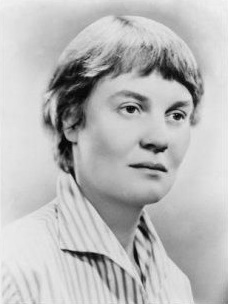
Dame Jean Iris Murdoch was an Irish and British novelist and philosopher. Murdoch is best known for her novels about good and evil, sexual relationships, morality, and the power of the unconscious. Her first published novel, Under the Net (1954), was selected in 1998 as one of Modern Library's 100 best English-language novels of the 20th century. Her 1978 novel The Sea, the Sea won the Booker Prize. In 1987, she was made a Dame by Queen Elizabeth II for services to literature. In 2008, The Times ranked Murdoch twelfth on a list of "The 50 greatest British writers since 1945".
Barrington J. Bayley was an English science fiction writer.

The Centauri Device is the third novel by English author M. John Harrison. The novel, originally conceived as an "anti-space opera" would ultimately go on to make a major contribution to revitalising the subgenre and influencing the works of later authors such as Iain M. Banks and Alastair Reynolds.
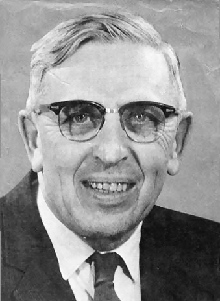
Clifford Donald Simak was an American science fiction writer. He won three Hugo Awards and one Nebula Award. The Science Fiction Writers of America made him its third SFWA Grand Master, and the Horror Writers Association made him one of three inaugural winners of the Bram Stoker Award for Lifetime Achievement.

The Garments of Caean is the seventh novel by the science fiction author Barrington J. Bayley. He described it as being his attempt to create a Vancian space opera.

The Pillars of Eternity is the tenth novel by the science fiction author Barrington J. Bayley.
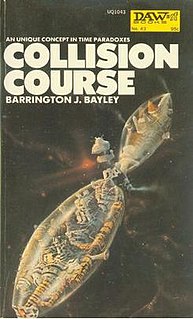
Collision Course is the fourth novel by the science fiction author Barrington J. Bayley. The novel was inspired by the multiple time dimensions proposed by J. W. Dunne. The plot centers on the collision of two alternate "presents", with disastrous implications for reality.

The Fall of Chronopolis (ISBN 0-87997-043-X) is the fifth novel by the science fiction author Barrington J. Bayley. It details the eternal conflict through time between the Chronostatic Empire and its enemy, the Hegemony.

The Grand Wheel is the eighth science fiction novel by Barrington J. Bayley. The novel follows Cheyne Scarne, a professor of "randomatics", as he is selected by the eponymous organization to represent humanity in a card game with infinitely varying rules. The name of the main character appears to be a reference to John Scarne.

The Star Virus is the first science fiction novel by Barrington J. Bayley, expanded from a 1964 short story originally published in New Worlds. The plot centers on the attempts of humanity, the star virus of the title, to break through a barrier around the galaxy.

Annihilation Factor is the second science fiction novel by Barrington J. Bayley, expanded from a 1964 short story originally published in New Worlds. It centres on the strains placed on a galactic empire by the appearance of the mysterious, planet-devouring "patch".

Empire of Two Worlds is the third science fiction novel by Barrington J. Bayley. The main characters are "tankless" inhabitants of a dim and dry colony world who attempt to find a lost gateway back to Earth.

Star Winds is the ninth science fiction novel by Barrington J. Bayley. In the future Solar System of the novel, humans travel through space using solar sails and, as with much of Bayley's work, alchemy and other pseudosciences play a role alongside more conventional technology.
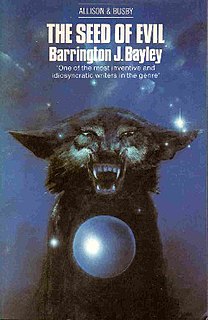
The Seed of Evil is the second science fiction collection by Barrington J. Bayley. The book collects thirteen short stories published between 1962 and 1979, several of which are original to this volume.

The Rod of Light is the thirteenth science fiction novel by Barrington J. Bayley and his only sequel. The book continues the story of Jasperodus, who is now in conflict with Gargan, a ruthless robot attempting to make his own soul.

The Forest of Peldain is the twelfth science fiction novel by Barrington J. Bayley. Set on the water world of the Hundred Islands, the Arelian empire attempts to seize control of the last island, Peldain, which within its dense forests contains an independent kingdom and an ancient secret.

The Sinners of Erspia is the fifteenth science fiction novel by Barrington J. Bayley. The main character is the interstellar courier Laedo, who is stranded on the bizarre artificial planetoid Erspia. The novel focuses on his attempts to gain an understanding of Erspia and Erspia's creator, the god-like Klystar. The novel was completed in 1997 and was first published as a print-on-demand book in 2002.
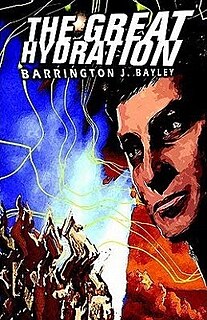
The Great Hydration is the sixteenth and last science fiction novel by Barrington J. Bayley. The book was written in 1998 and first published as a print on demand edition in 2002. The book features the illegal traders Krabbe and Bouche, the first humans to reach the planet of Tenacity, as they proceed to destroy the planet's anhydrous economy in an attempt to make a quick profit.
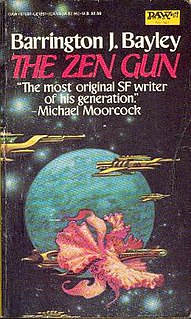
The Zen Gun is the eleventh science fiction novel by Barrington J. Bayley.

The Knights of the Limits is the first science fiction collection by Barrington J. Bayley. The book collects nine short stories published between 1965 and 1978, one of which is original to this volume.



















